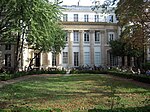Yves Saint Laurent (brand)
1980s fashion1990s fashion2000s fashion2010s fashion2020s fashion ... and 22 more
Cigarette brandsClothing brands of FranceClothing companies established in 1962Clothing companies of FranceClothing retailers of FranceComité Colbert membersCompanies based in ParisCosmetics brandsCosmetics companies of FranceDesign companies established in 1962Eyewear brands of FranceFashion accessory brandsFrench companies established in 1962Gucci brandsHigh fashion brandsJewellery retailers of FranceLuxury brandsPerfume housesRetail companies established in 1962Shoe companies of FranceUse mdy dates from September 2022Yves Saint Laurent (brand)

Yves Saint Laurent SAS (; UK: ; US: ; French: [iv sɛ̃ lɔʁɑ̃] (listen)), also known as Saint Laurent and YSL, is a French high-end luxury fashion house founded in 1962 by Yves Saint Laurent and his partner, Pierre Bergé. The company specializes in haute couture, ready-to-wear, leather accessories, and footwear. Its cosmetics line, YSL Beauty, is owned by L'Oréal.
Excerpt from the Wikipedia article Yves Saint Laurent (brand) (License: CC BY-SA 3.0, Authors, Images).Yves Saint Laurent (brand)
Rue de Bellechasse, Paris 7th Arrondissement (Paris)
Geographical coordinates (GPS) Address Nearby Places Show on map
Geographical coordinates (GPS)
| Latitude | Longitude |
|---|---|
| N 48.8569469 ° | E 2.3216936 ° |
Address
Rue de Bellechasse
75007 Paris, 7th Arrondissement (Paris)
Ile-de-France, France
Open on Google Maps









